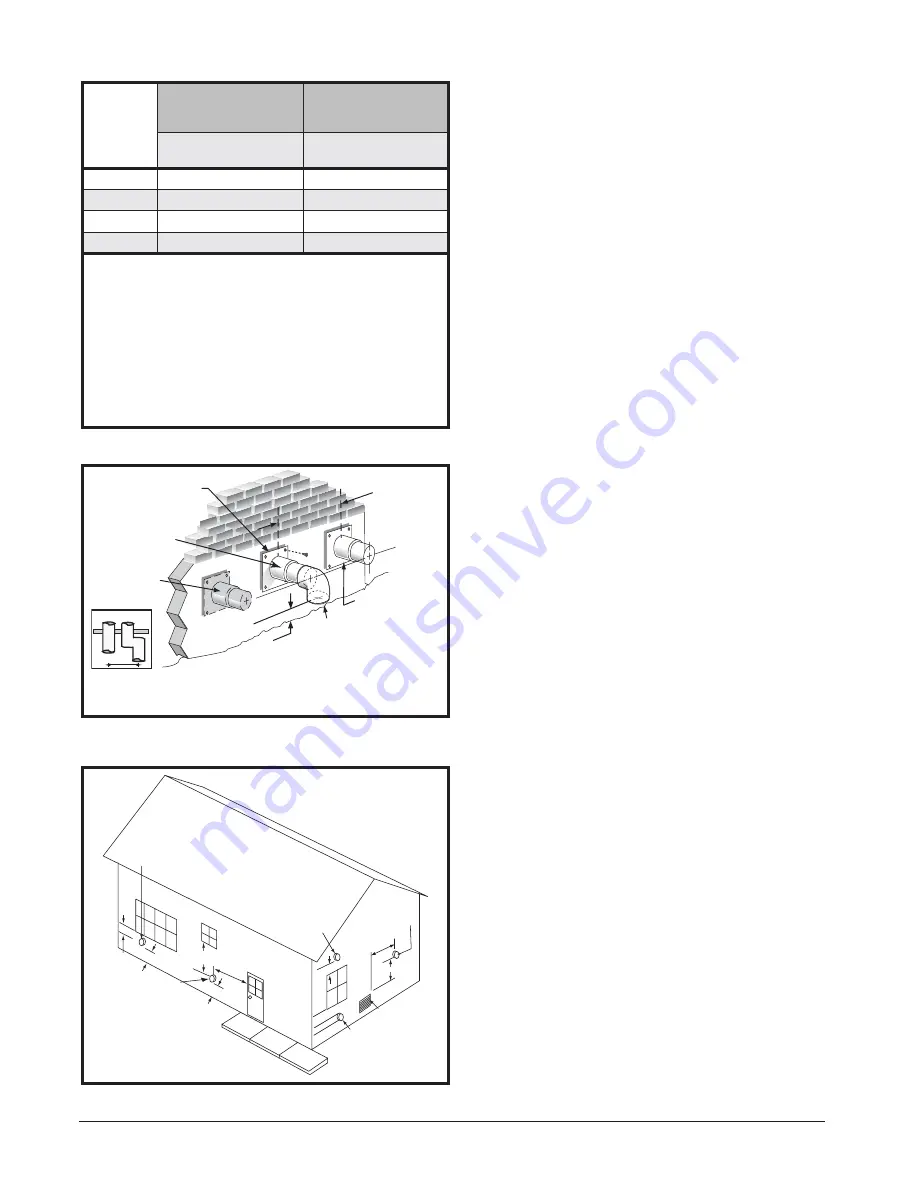
9
• The quality of outdoor air must also be considered. Be
sure that the combustion air intake is not located near
a source of solvent fumes or other chemicals which can
cause corrosion of the furnace combustion system.
• Route piping as direct as possible between the furnace
and the outdoors.
• If a Direct Vent (2-pipe) system is used, the combustion
air intake and the vent exhaust must be located in the
same atmospheric pressure zone. This means both pipes
must exit the building through the same portion of exterior
wall or roof as shown in Figure 30 (page 34). Vent piping
must be sloped upwards 1/4” per foot in the direction
from the furnace to the terminal. This is to ensure that
any condensate fl ows back to the condensate disposal
system.
• Piping must be mechanically supported so that its weight
does not bear on the furnace. Pipe supports must be
installed a minimum of every 5 feet along the vent run to
ensure no displacement after installation. Supports may
be at shorter intervals if necessary to ensure that there
are no sagging sections that can trap condensate. It is
recommended to install couplings along the vent pipe,
on either side of the exterior wall (Figure 30). These
couplings may be required by local code.
Outdoor Terminations - Horizontal Venting
Vent termination clearances must be consistent with the
IFGC and in accordance with these instructions.
• Vent and combustion air intake terminations shall be
installed as shown in Figures 6 & 7.
• All minimum clearances (Figure 7) must be maintained
to protect building materials from degradation by fl ue
gases.
• Vent and combustion air intake terminations must
be located to ensure proper furnace operation and
conformance to applicable codes. Figure 7 lists the
distances from the vent termination to windows and
building air intakes.
• For optimal performance, vent the furnace through a
wall that experiences the least exposure to winds
.
• Do not install the vent terminal such that exhaust is
directed into window wells, stairwells, under decks or into
alcoves or similar recessed areas, and do not terminate
above any public walkways.
• If venting horizontally, a side wall vent kit is available
according to the pipe diameter size of the installation (kit
# 904349).
Please follow the instructions provided
with the kit.
• Concentric vent termination kits are available for use
with these furnaces (kit # 904176).
Please follow the
instructions provided with the kit.
• When the vent pipe must exit an exterior wall close to
the grade or expected snow level where it is not possible
to obtain clearances shown in Figure 6, a riser may be
provided as shown in Figure 8 (page 10). Insulation is
required to prevent freezing of this section of pipe. See
vent freezing protection information below.
12 in.
12 in.
4 ft.
Note 2
Mechanical
draft vent
terminal
Direct vent
terminal
50,000 Btuh
or less
Forced
Air Inlet
Direct vent
terminal -
more than
50,000 Btuh
Mechanical
draft vent
terminal
Mechanical
draft vent
terminal
Less
than 10 ft.
3 ft.
NOTES:
1. All dimensions shown are minimum
requirements.
2. Exterior vent terminations must be located at
least 12 In above the maximum expected snow level.
Note 2
Note 2
9 In.
4ft.
Figure 7 Vent Locations
12" Min.
to Maxim
um
Expected Sno
w Le
vel
Typical Both Pipes
36" max.
8" min.
Exhaust V
ent
Right Side Option
Mounting Kit
Faceplate Secured
to Wall with Screws
Typical Both Pipes
Combustion
Air Inlet
Inlet Exhaust
Both Sides
Exhaust Vent
Left Side Option
90°
Elbo
w
Figure 6. Exhaust and Combustion Air
Pipe Clearances
Table 2. Vent Pipe Lengths (FT.)
FURNACE
MODELS
SINGLE VENT PIPE
with 1 long
radius elbow*
DUAL VENT PIPE
with 1 long radius
elbow on each pipe*
OUTLET
3” Diameter
INLET/OUTLET
3” Diameter
XC046
80
80
XC061
80
80
XC076
80
80
XC102
80
80
*NOTES:
1. These lengths apply for elevations from sea level to 2,000 ft. For
higher elevations decrease vent pipe lengths by 8% per 1,000
ft. of altitude.
2. When calculating vent lengths, subtract 2.5 ft. for each additional
2" elbow and 3.5 ft. for each additional 3" elbow. Two 45° elbows
are equivalent to one 90° elbow. One short radius elbow is
equivalent to two long radius elbows. Do not include termination
elbows in calculation of vent length.
3. The length of pipe needed between the inducer and the fi nish
fl ange is 7 3/4”.








































